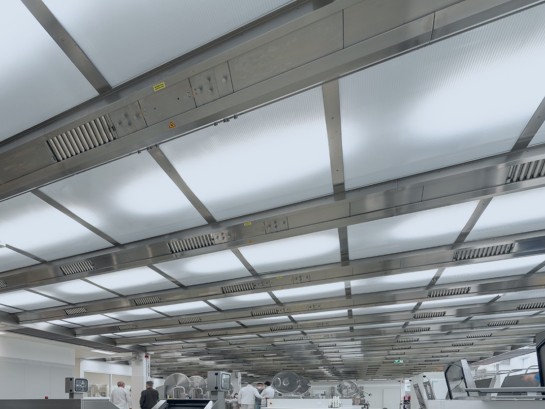Blog
Published:
Industrial vs. Kitchen Ventilation – Key Differences and What to Watch Out For
Ventilation systems are essential in every facility, but requirements differ greatly across environments. While industrial halls and offices focus on removing heat, dust and CO₂, professional kitchens must handle grease, moisture and strict hygiene standards. Below we explain why kitchen ventilation requires different technologies than standard industrial ventilation, outline the key differences, and show how to choose the right HVAC system — with real-world examples.

Industrial Ventilation: Output and Stability
Industrial HVAC systems are used in factories, warehouses or schools. Their tasks are to:
- remove excess heat, dust and pollutants,
- ensure sufficient fresh air,
- maintain a stable indoor climate with low operating costs.
In most cases these are standard ventilation systems moving large air volumes and using basic filters, because the air is not loaded with grease or high humidity. A typical example is the V-Tower in Prague — one of the most advanced buildings in the Czech Republic, where ATREA delivered a high-efficiency HVAC with strong heat recovery and user comfort in mind.

Kitchen Ventilation: Extreme Load and Strict Standards
Commercial kitchens are much more demanding. Kitchen ventilation must deal with:
- high temperatures and steam,
- grease aerosols depositing in filters and ductwork,
- strong odours migrating to adjacent spaces,
- hygiene standards EN 16282 and VDI 2052.
That’s why specialised technologies are used: professional kitchen hoods, heat recovery units, TPV ventilation ceilings, and multi-stage filtration (lamella, cyclone, UV-C). A poorly designed system can cause grease build-up, condensation, mould and a higher fire risk.
A modern solution is illustrated by the Královka project in the Jizera Mountains, where ATREA installed a TPV ventilation ceiling with heat recovery. The system ensures up to 99% capture of grease aerosols, odour elimination and a comfortable environment for chefs and guests in the open kitchen.

Main Differences Between Industrial and Kitchen Ventilation
- Air characteristics: industry — dust & heat; gastronomy — grease, steam & odour.
- Extraction elements: industry — standard ducting; gastronomy — kitchen hoods, TPV ventilation ceilings.
- Hygiene & safety: industry — basic filtration; gastronomy — multi-stage filtration, UV-C, strict standards.
How to Choose the Right System
Selection depends primarily on the size and character of the operation. Smaller kitchens with concentrated cooking blocks benefit from supply & extract hoods.
Medium and large operations (school canteens, hospital kitchens, hotel restaurants) appreciate the flexibility of ventilation ceilings, which provide full-area capture, quality lighting and easy adaptation when layouts change.
In all cases, heat recovery is increasingly the norm, cutting energy costs while improving comfort and sustainability.


ATREA’s Experience
ATREA has 30+ years of experience in designing and delivering ventilation systems. We supply solutions for industrial buildings and gastronomy — from standard HVAC to specialised OPTIMA hoods and TPV ventilation ceilings. Every project is tailored to its specific conditions and customer needs.
Contact Us
Planning a new facility or a kitchen retrofit? We’ll design a solution that is hygienically safe, energy-efficient and adapted to your exact requirements.
Get in touch — let’s create a project that truly works.
Written by:
Jan Foret, Commercial Kitchen Ventilation Expert
Contact us
Tell us how we can help
Do you have questions, need advice, or want more information about our products and services? Let us know through this contact form. Our team will respond as soon as possible with a solution customized just for you.



